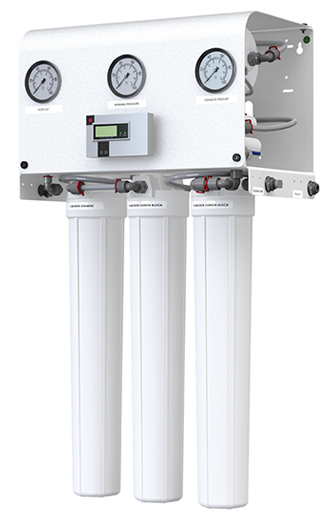
REVERSE OSMOSIS SYSTEMS
with optional cover, pressure gauges and TDS meter
Video
Product Images

FEATURES
- AXEON TF– 3012 500 Membrane Element
- AXEON 3012 Membrane Housing
- AXEON 2.5" x 20" 5-Micron Sediment Pre-Filter
- AXEON 2.5" x 20" 10-Micron Carbon Block Pre-Filter and Post-Filter
- Pentair® 20" Slim Line Filter Housings
- Automatic Shut Off Valve
- Push/Pull Fittings with Locking Safety Clip
OPTIONS AND UPGRADES
- 20" Floor Stand
-
Cover with Glycerin-Filled Pressure
Gauges Including:- Post-Filter Pressure Gauge
- Operational Pressure Gauge
- Permeate Pressure Gauge
- HM-Digital® DM-2 Dual TDS Meter
- Cover without Pressure Gauges
- Blending Valve
- 10" Filter Housings
SPECIFICATIONS
| MODELS | LP– 350 | LP– 500 | LP – 700 |
|---|---|---|---|
| Design | |||
| Configuration | Single Pass | Single Pass | Single Pass |
| Feedwater SourceA | TDS < 500 | TDS < 500 | TDS < 500 |
| Standard Recovery Rate % | 40 | 46 | 38 |
| Flow RatesB | |||
| Permeate Flow (gpm / lpm) | 0.24 / 0.91 | 0.35 / 1.31 | 0.49 / 1.85 |
| Minimum Feed Flow (gpm / lpm) | 0.66 / 2.50 | 0.76 / 2.88 | 1.33 / 5.03 |
| Maximum Feed Flow (gpm / lpm) | 8.00 / 30.28 | 8.00 / 30.28 | 8.00 / 30.28 |
| Connections | |||
| Feed (in) | 3/8 QC | 3/8 QC | 3/8 QC |
| Permeate / Holding Tank (in) | 3/8 QC | 3/8 QC | 3/8 QC |
| Concentrate (in) | 3/8 QC | 3/8 QC | 3/8 QC |
| Membranes | |||
| Membrane Per Vessel | 1 | 1 | 1 |
| Membrane Quantity | 1 | 1 | 2 |
| Membrane Size | 3012 | 3012 | 3012 |
| Nominal TDS Rejection % | 98 | 98 | 98 |
| Vessels | |||
| Vessel Array | 1 | 1 | 2 (Parallel) |
| Vessel Quantity | 1 | 1 | 2 |
| Pumps | |||
| Pump Included | No | Yes | No |
| Pump Type | N/A | Aquatec 5800 | N/A |
| System Electrical | |||
| Standard Voltage + Amp Draw | N/A | 110V, 50 / 60Hz, 1PH, 4A | N/A |
| System Dimensions | |||
| Approximate Dimensions C L x W x H (in /cm) | 12.00 x 17.00 x 32.00 / 30.48 x 43.18 x 81.28 | 12.00 x 17.00 x 32.00 / 30.48 x 43.18 x 81.28 | 12.00 x 17.00 x 32.00 / 30.48 x 43.18 x 81.28 |
| Approximate Weight (lbs / kg) | 35 / 15.87 | 41 / 18.60 | 38 / 17.24 |
Test Parameters: : 550 TDS Filtered (5-Micron), Dechlorinated, Municipal Feedwater, 65 psi / 4.50 bar Feed Pressure, 100 psi / 6.8 bar Operating Pressure, 77°F / 25°C, Recovery as stated, 7.0 pH. Data taken after 60 minutes of operation.
A. Low temperatures and feedwater quality, such as high TDS
levels will significantly affect the systems production
capabilities and performance. Computer projections must be run for
individual applications which do not meet or exceed minimum and
maximum operating limits for such conditions.
B. Product flow and maximum recovery rates are based on feedwater
conditions as stated above. Do not exceed recommended permeate
flow.
C. Does not include operating space requirements.
OPERATING LIMITS
| Maximum Feed Temperature (°F / °C) | 85 / 29 | Maximum Turbidity (NTU) | 1 |
| Maximum Feed Temperature (°F / °C) | 40 / 4 | Maximum Free Chlorine (ppm) | 0 |
| Maximum Ambient Temperature (°F / °C) | 120 / 49 | Maximum TDS (ppm) | 500 |
| Minimum Ambient Temperature (°F / °C) | 40 / 4 | Maximum Hardness (gpg) | 1 |
| Maximum Feed Pressure (psi / bar)D | 90 / 6 (LP– 350, LP– 700); 70 / 5 (LP– 500) | Maximum pH (continuous) | 10 |
| Minimum Feed Pressure (psi / bar)D | 70 / 5 (LP– 350, LP– 700); 45 / 3 (LP– 500) | Minimum pH (continuous) | 4 |
| Maximum Operating Pressure (psi / bar) | 90 / 6 (LP– 350, LP– 700); 100 / 7 (LP– 500) | Maximum pH (cleaning 30 minutes) | 12 |
| Maximum Feed Silt Density Index (SDI) | < 1 | Minimum pH (cleaning 30 minutes) | 2 |
D. System pressure is variable due to water conditions. Permeate flow will increase at a higher temperature and will decrease at a lower temperature.
THE RIGHT SOLUTION FOR YOU
Contact us today for more information about our products and services.
CONTACT US
